hnsc 1210 unit 9 - energy balance and a healthy body weight
1/167
There's no tags or description
Looks like no tags are added yet.
Name | Mastery | Learn | Test | Matching | Spaced |
|---|
No study sessions yet.
168 Terms
weight and health
body size alone does not equal health
body composition (fat, muscle, bone, and tissue that make up body weight) is most related to health outcomes
being overweight or underweight can present health problems in some individuals
energy balance
occurs when calories coming into our body (energy intake) equal the calories that our body is expending (energy expenditure)
energy intake comes from food and beverages we consume - contribute to calories
if you had 1 cup of juice at breakfast, a 120z glass of ice tea at lunch and a 12 glass of coke at supper this would approx. 400 calories to your day
food intake regulation
internal and external factors that contribute to obesity
appetite
eating behaviour is regulated by “go: mechanisms that simulate eating (hunger and appetite) and “stop” mechanisms that signal the body to cease/refrain from eating (satiation and satiety)
hunger
physiological need to eat
unpleasant sensation that demands relief, a drive to obtain food
much more powerful stimuli that satiety and protein is the most satiating of the nutrients
appetite
physiological desire to eat
learned motivated and a positive sensation that accompanies the sight, smell, or thought of appealing food
satiation
perception of fullness that builds throughout a meal, eventually reaching the degree of fullness/satisfaction that stops eating
generally determines how much food is consumed in one sitting
satiety
perception of fullness that lingers after a meal, inhibiting eating until the next meal
determines the length of time between meals
hunger, appetite, satiation, and satiety
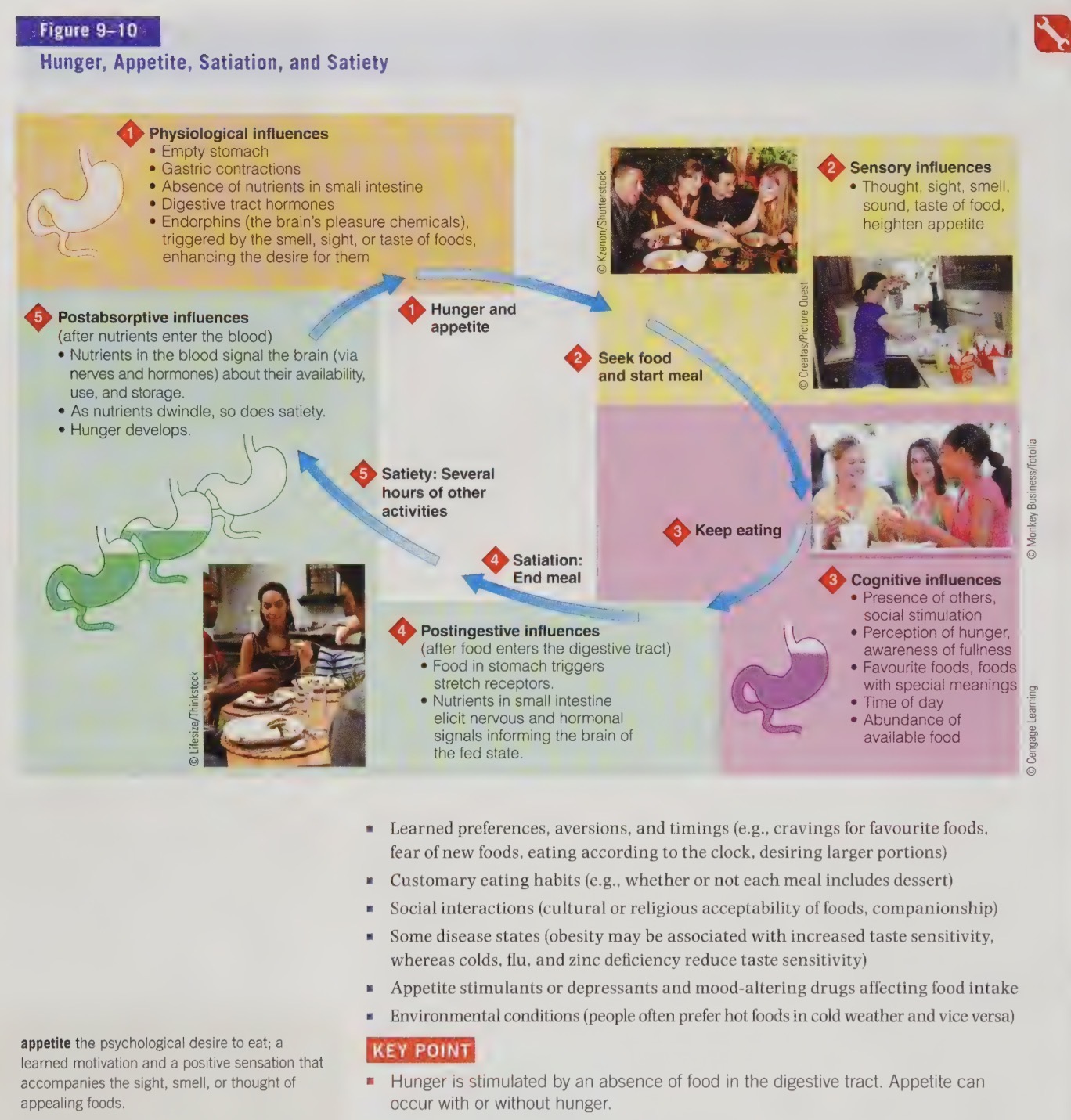
food intake regulation: inside the body
many factors that regulate food intake inside of body: hormones
leptin
appetite suppressing hormone that is produced in fat cells
coveys information about body fatness to the brain, working to suppress appetite and food intake between meals
some produced in stomach
leptin feedback loop
↑ Body fat → ↑ leptin → ↓ appetite
↓ Body fat → ↓ leptin → ↑ appetite
what happens when an organism cannot produce leptin
severe obesity due to uncontrolled appetite (ex. genetically obese mouse without leptin gene)
why is the genetically obese mouse given leptin lean?
external leptin restores appetite regulation and prevents overeating
besides leptin, what internal factors affect food intake
microbiota
inborn appetite
disease states
sleep deprivation
food intake regulation: outside the body factors
environmental and emotional influences that affect how much and what we eat
how does pleasure influence food intake
some people eat more because food provides enjoyment, comfort, or satisfaction
what food items do people have a tendency to overconsume
delectable items
sweats
snacks
condiments
main dishes
What is the “variety effect” on eating behavior?
People tend to eat more when offered many food choices (e.g., buffets) compared to meals with fewer options.
What emotions commonly lead to overeating?
Boredom, loneliness, sadness, and even happiness.
consuming food in response to emotions rather than hunger cues
outside factors contributing to obesity and overweight
over eating can occur due to a number of factors:
stress
time of day (ex. break)
food pricing and availability (ex. healthy foods expensive)
advertisement (ex. food marketing budgets)
physical inactivity
What are the three ways the body expends energy?
basal metabolic rate (BMR)
voluntary activity
thermic effect of food
What is BMR?
sum of all involuntary activities necessary to maintain life, excluding digestion and voluntary activities
e.g., circulation, respiration, temp maintenance, hormone secretions, nerve activities, and new tissue synthesis
varies from person to person
What is voluntary activity in energy expenditure?
Intentional activities such as walking, sitting, running, etc. conducted through voluntary muscle movements.
What is the thermic effect of food?
The body’s metabolism speeds up for approximately five hours after a meal.
Which component accounts for the greatest portion of energy expenditure?
Basal metabolism (BMR).
Rank the components from largest to smallest contribution.
BMR → voluntary activity → thermic effect of food.
What happens when energy intake exceeds energy expenditure?
Excess energy is stored as fat in fat cells.
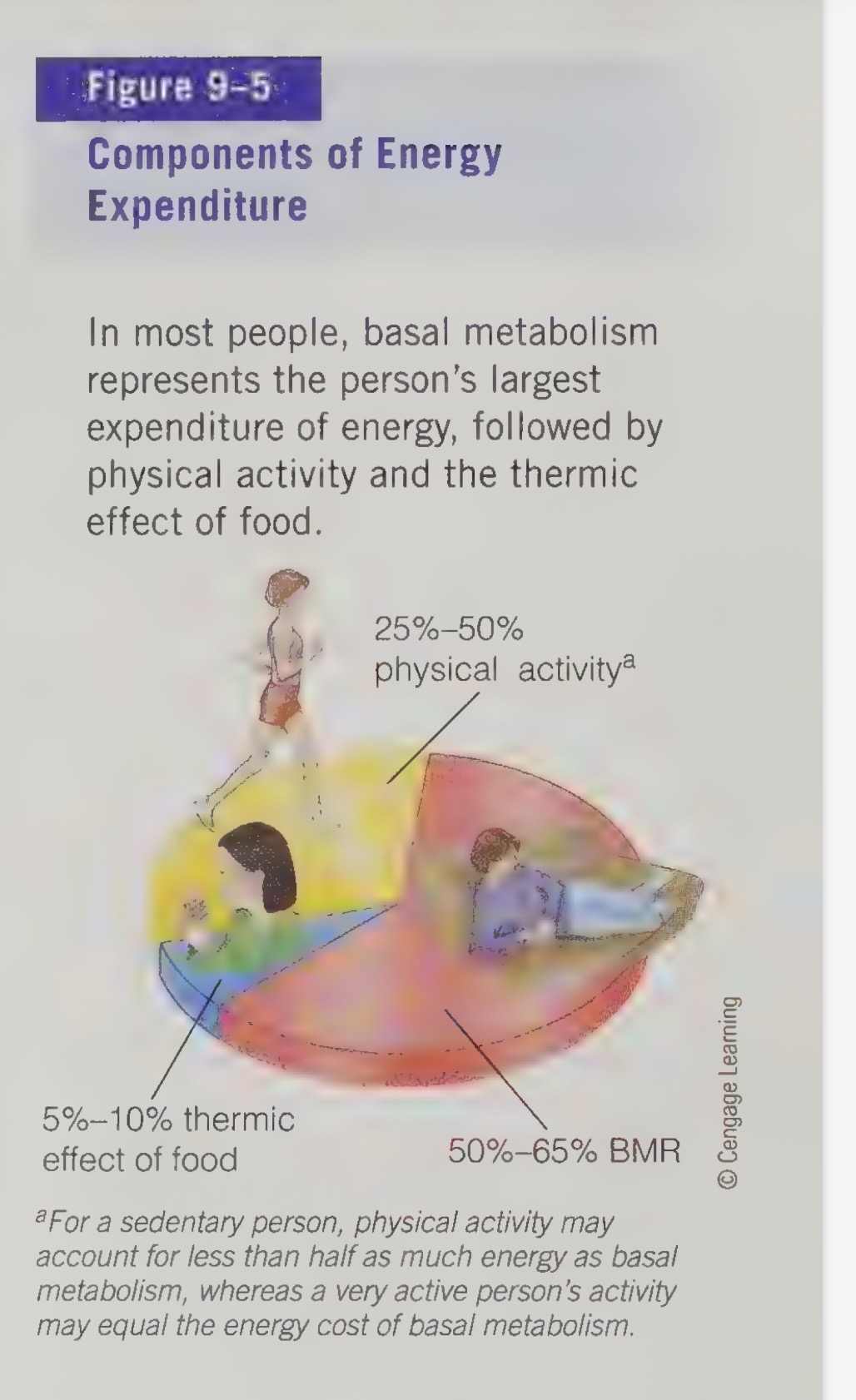
factors that affect BMR
age, higher in children and creases with age
height, taller people have higher BMR because more surface area
period of growth, have a higher BMR (ex. children and pregnancy)
body composition, more lean muscle mass higher BMR
fever and stress, increase BMR
environmental temp., increases BMR
fasting, starvation, malnutrition, lower BMR (make weight loss tricky)
thyroxine, higher levels, higher BMR
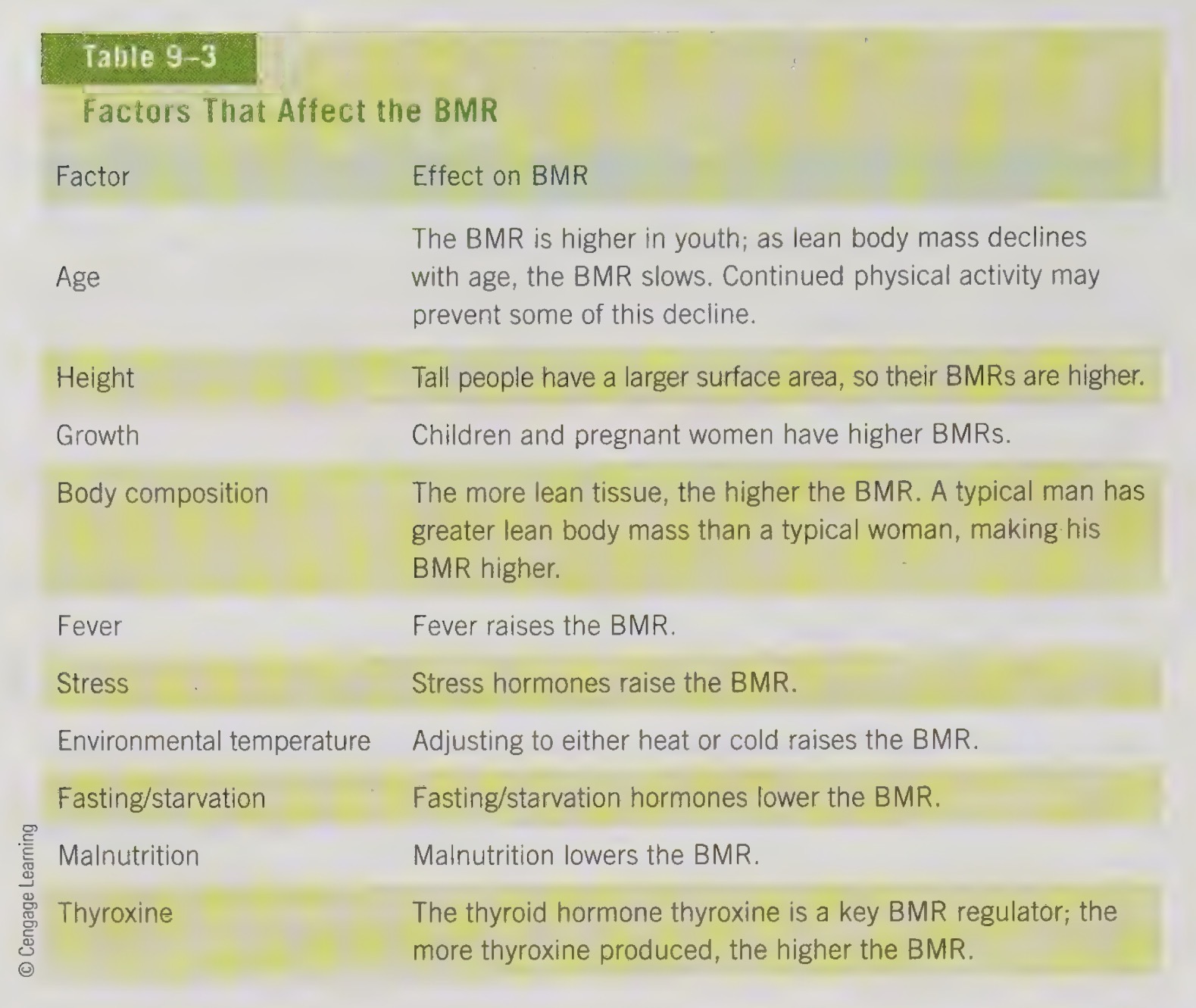
when energy intakes exceeds energy expenditure
excess fat accumulates in fat cells
how much fat do your store for each 3,500 calories you eat excess in expenditure
one pound of fat
how much fat do you lose for each 3,500 calories that you expend in excess of need
one pound
to lose 1 pound of fat in one week, need to expend 500 calories per day
what does the body do when energy intake is less than energy expended
body draw on fat stores
to loose one pound of fat
must expend 3,500 calories more then you consume
estimated energy requirement (EER)
calculation to determine the number of calories your body needs
how to calculate EER
find equation for your gender below
insert age in years, weight (wt) in kg, height (ht) in meters
your physical activity number (PA) found on table
equation
women age 19 years or older: EER = 354 - 6.91 x age + PA x [9.36 x wt) + (726 x ht)
men age 19 years or older EER = 662 - 9.53 x age + PA x [{15.91 x wt) + (539.6 x ht)]
EER calculations should take into account
Gender: because body composition differs between men and women, which will affect energy requirements
Age: because energy requirements decrease as we age
Height and weight: because energy requirements are higher for those taller or heavier
Physical activity level: because physical activity will use more energy
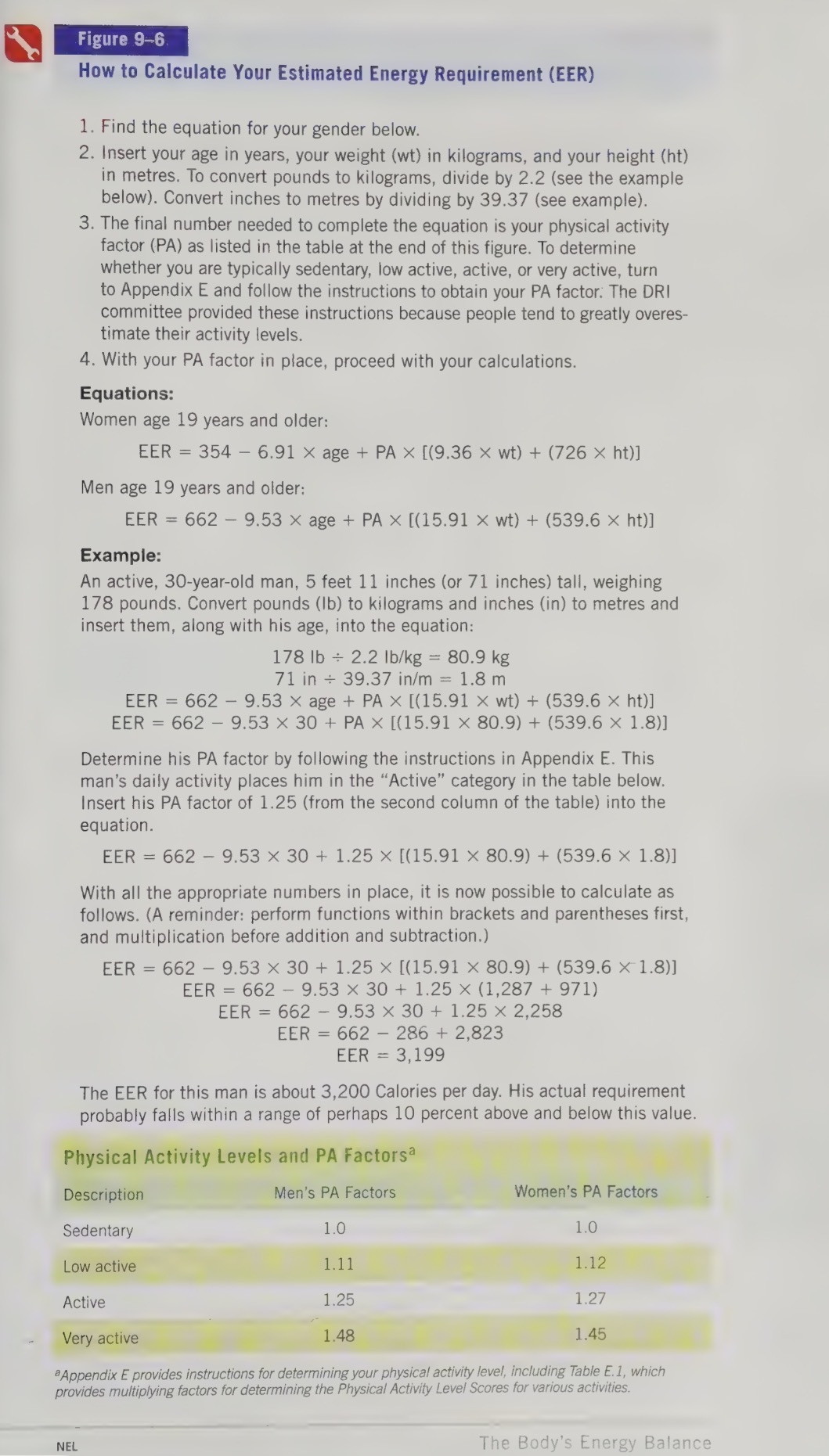
calculation for BMI
your weight in kg divided by your height in meters squared (to convert lb to kg – divide wt in lbs by 2.2. To convert ht in inches to ht in cm, multiply ht in inches by 2.54).
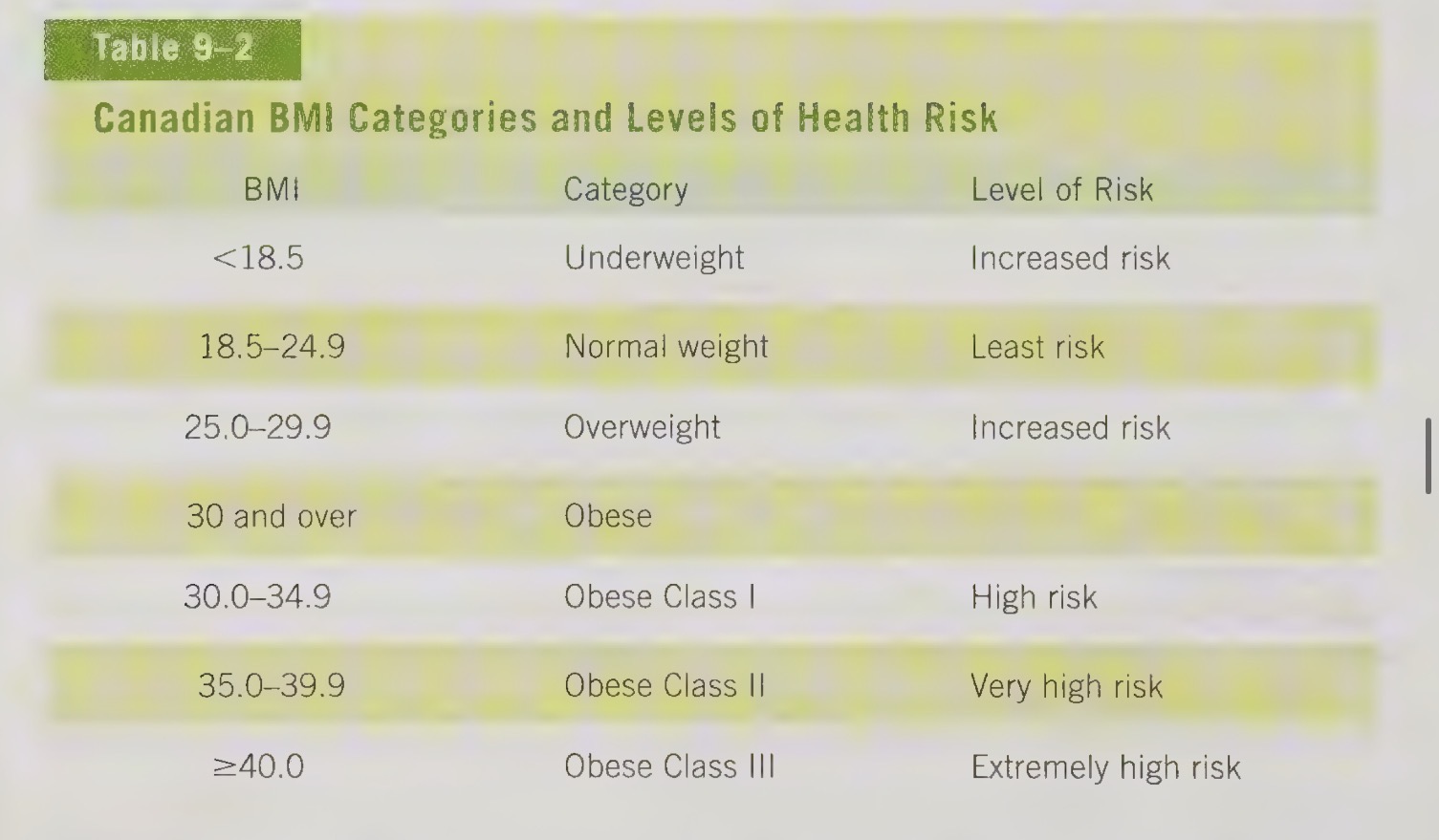
BMI
weight in kg/(height in m)2
used to evaluate a person health risk associated with being underweight and overweigh
more affecting for assessing degree of weight
BMI scale
Underweight BMI: <18.5
Normal weight BMI: 18.5-24.9
Overweight BMI: 25-29.9
Obese (class I) BMI: 30 – 34.9
Obese (class II) BMI: 35 – 39.9
Extreme Obesity (class III) BMI: >40
BMI used as proxy for
health behaviours, fitness, dietary quality and interventional adherence in older literature when we should instead measure these directly.
What do World Health Organization and National Institute of Health normal BMI ranges help predict?
Lower risk for certain diseases, such as Type II Diabetes
Why is using the same BMI ranges for men and women flawed?
It can misclassify chronic disease risk, especially in individuals labeled “overweight.”
What key factor does BMI fail to account for between men and women?
differences in adiposity (body fat levels).
How do adiposity levels naturally differ between men and women?
Women typically have higher adiposity than men.
Why is BMI not a good tool to measure health status?
It oversimplifies health and can misclassify both larger-bodied and smaller-bodied individuals.
How does BMI misclassify people in larger bodies?
It may label healthy, fit individuals as “unhealthy” solely based on weight.
How does BMI misclassify people in smaller bodies?
t may label unhealthy individuals as “healthy” if they are slim, even if they have poor lifestyle habits.
Who created BMI and for what purpose?
A mathematician in the 1800s developed BMI to categorize populations—not to assess individual health.
Does BMI accurately predict a person’s health?
No, BMI was not based on health measures and does not predict individual health outcomes.
What important factors does BMI fail to measure?
Muscle mass, bone mass, and fat mass (body composition).
Why can BMI give a misleading impression of someone’s health?
It doesn’t consider lifestyle factors, metabolic health, or behaviors like smoking or alcohol use.
Give an example of how BMI can mislead health status in a slim person.
A slim person who smokes and drinks daily may have a “healthy” BMI but poor actual health.
BMI limitations
need to compare all body mass and size, i.e looking at all different dog species, not just fat and skinny poodles
anthropometry
A slim person who smokes and drinks daily may have a “healthy” BMI but poor actual health.
waist circumference
measures visceral fatness and disease risk.
You measure around the body at a point near the belly button. The person should exhale normally when the measurement is taken.
A higher waist circumference can indicate an increased risk of disease even if BMI is normal.
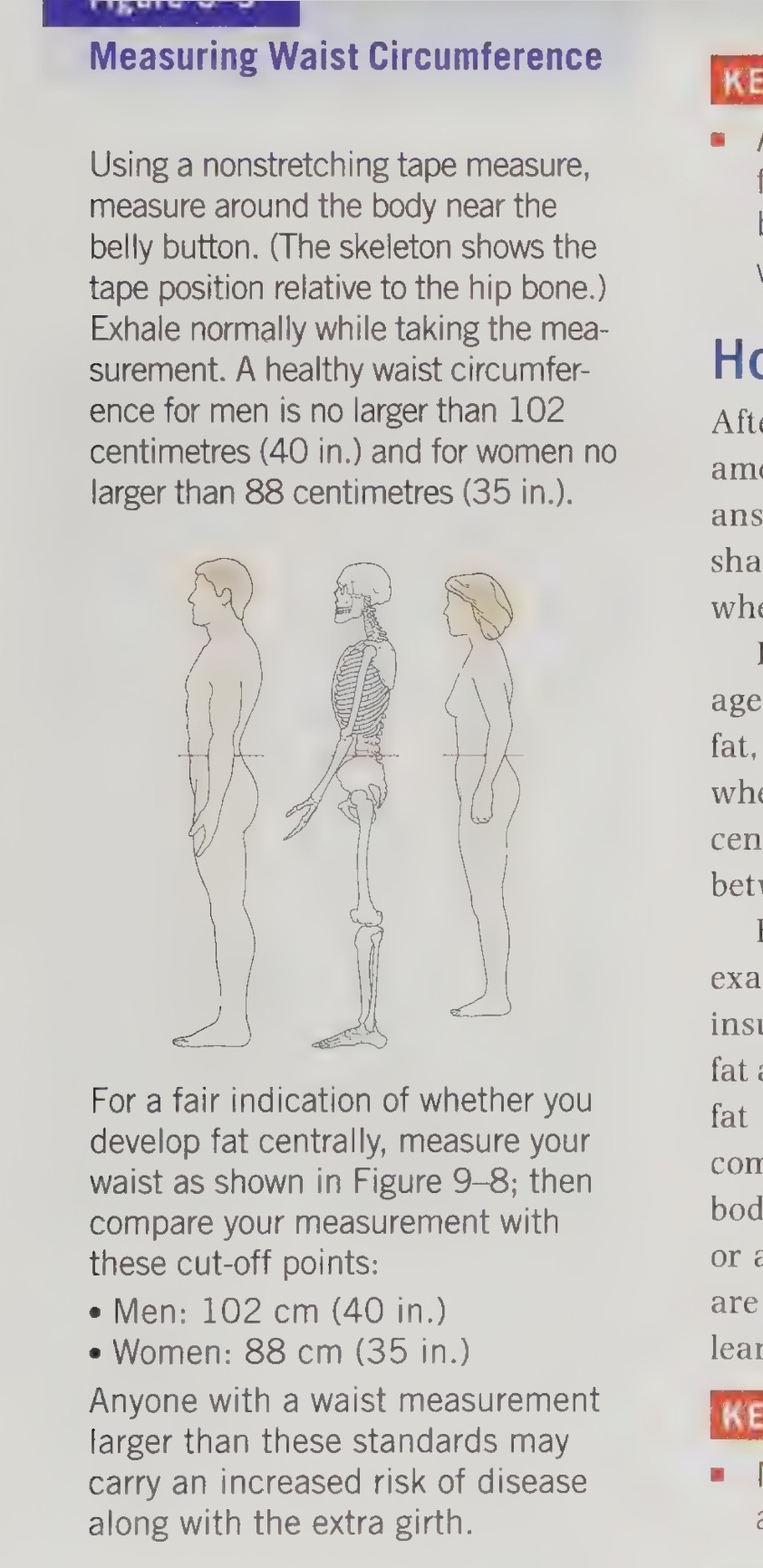
visceral fat
Fat stored in the abdominal cavity associated with an increased risk of disease (e.g. CVD, diabetes, stroke, hypertension).
What is central obesity?
Fat carried around the abdomen/stomach area (apple shape).
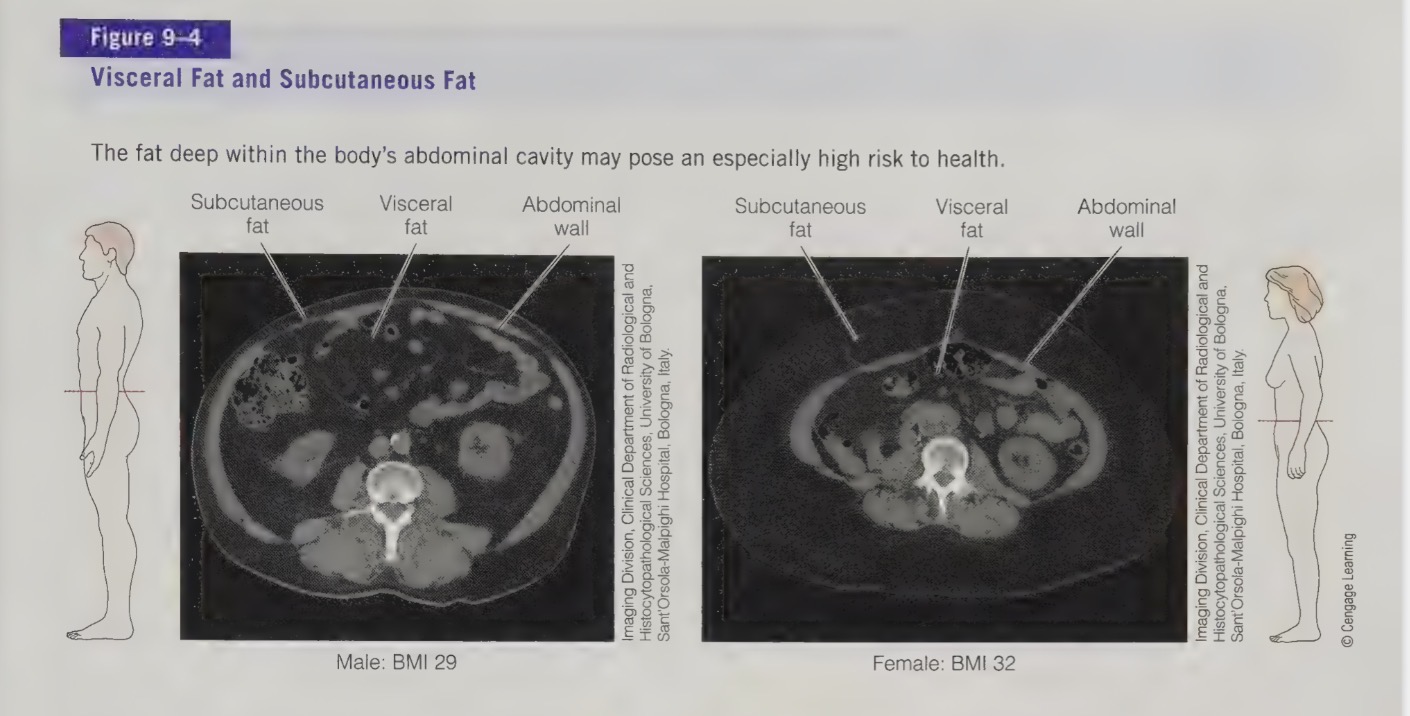
What is lower-body fat distribution?
Fat carried around the hips, thighs, and buttocks (pear shape).
Which body shape is considered less risky?
Pear shape (fat stored in lower body).
Why is apple shape linked to higher disease risk?
Central fat is more metabolically active and increases risk of chronic diseases (like heart disease, diabetes, etc.).
Which body shape is associated with lower risk: apple or pear?
Pear shape has lower risk; apple shape has higher all-cause mortality risk.
fat fold test
measure the thickness of a fold of skin at areas on the body using calipers
often back of arms, below shoulder blade, or skin from waist is tested and compared to standards
also called skin fold resr
provide estimate of total body fat and where fat is located
should be done by trained technician repeated
three methods of assessing body fatness
density (underwater/air displacement)
conductivity (BIA)
radiographic techniques (DEXA)
accuracy depends on skill of clinician performing test. if going for repeat have the same clinician perform the test
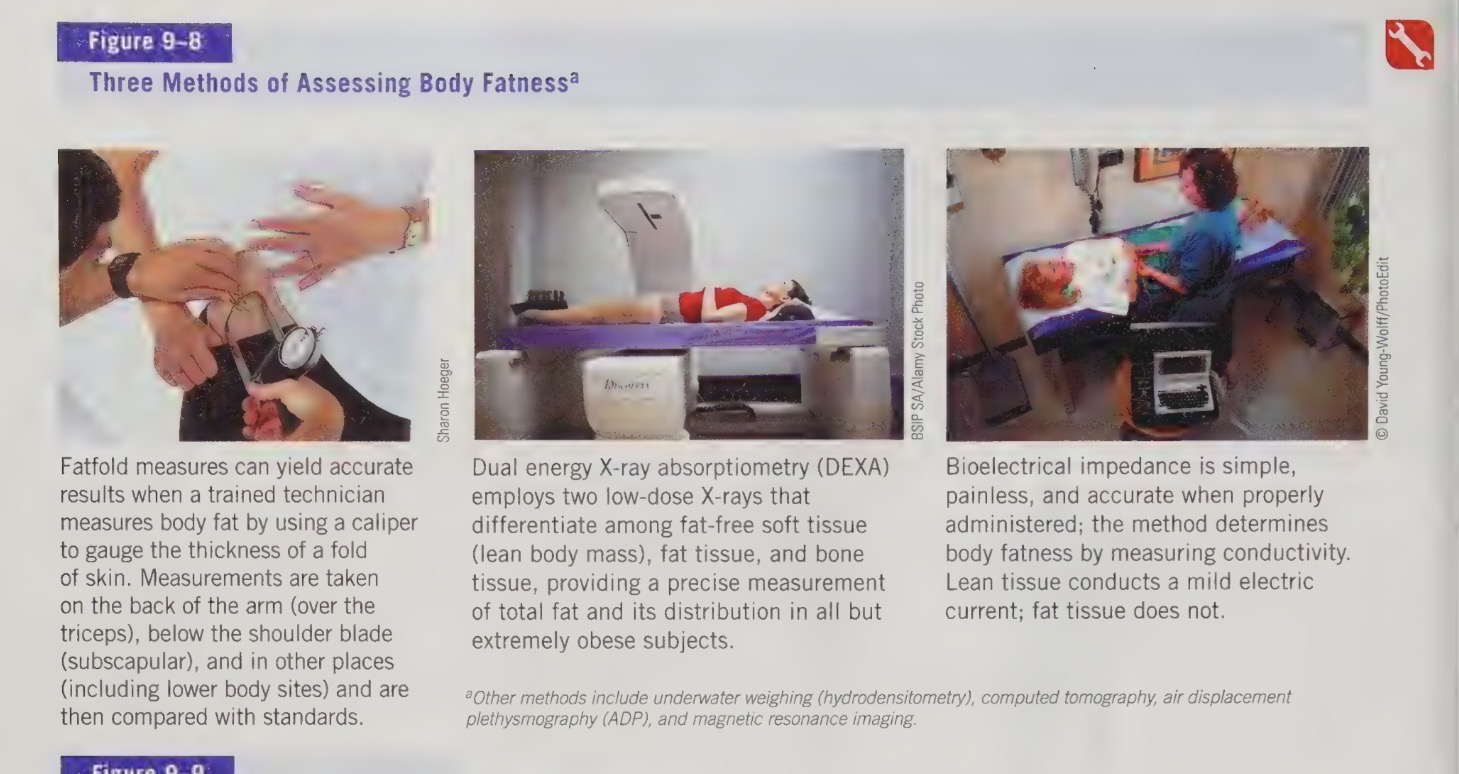
What is the density method of assessing body fatness?
Measures body weight compared to volume; lean tissue = denser than fat. Determined by underwater weighing or air displacement.
What is the conductivity method of assessing body fatness?
Measures how well the body conducts a small electrical current; lean tissue + water conduct electricity. Hydration status affects accuracy (overhydration → underestimates fat; dehydration → overestimates fat).
disadvantage: body’s water component can impact results, conducts electrical charge over hydration can underestimate body fatness, and dehydration can overestimate body fatness
What is the radiographic method of assessing body fatness?
Uses dual-energy X-ray absorptiometry (DEXA) to differentiate fat, lean tissue, and bone; provides precise measurements but is expensive and less accurate in extremely obese individuals.
disadvantage: expensive and not represent an accurate picture in extremely obese individuals
ideal amount of body fat for health depends on?
age and gender
maximum recommended body fat
Men under 40 years: 22%, over 40 years: 25%
Women under 40 years: 32%, over 40 years: 35%
besides gender and age, standards differ because of
lifestyle and stage of life
Why do competitive endurance athletes often have lower body fat?
They need just enough fat for fuel, insulation, and fat-soluble hormone activity; extra fat can hinder performance.
Why might northern fishermen have higher body fat?
Higher body fat provides insulation against cold temperatures.
How does body fat level affect pregnancy outcomes?
Too much or too little body fat can compromise pregnancy.
How does low body fat affect fertility?
Very low body fat can lead to infertility in some individuals.
How can high body fat impact fertility?
Excess body fat may also make it harder for some individuals to become pregnant.
Does losing weight automatically mean someone is healthier?
No. Health is based on behaviours (like walking and reducing soda), not just weight change.
What does research say about improving health?
Many behaviour changes improve health even without weight loss.
factors that effect weight
Genetics
Age
Hormones
Some medications
Some medical conditions
Family habits and culture
Social determinants of health
And many more...
how can we improve our health other than diet and excercise?
following healthy eating habits like balanced diet, regular exercise, limiting alcohol, and not smoking
reap health benefits of those activities, no matter how much we weight
why does doing these health eating habits not necessarily mean you will lose weight
body weight is an OUTCOME based on may factors
cannot directly control our weight because we cannot control all factors that determine weight
weight itself is not a behaviour or direct action, outcome
social determinants of health
broad range of person, social, economic, and environmental factors that determine individual and population health
main determinants of health
Income and social status
Employment and working conditions
Education and literacy
Childhood experiences
Physical environments
Social supports and coping skills. Did you know that maintaining social connections by engaging with family and friends can improve your health? Social support accounts for 30% of our health outcomes.
Healthy behaviours
Access to health services. Access to health care is another major effect on your health. You can improve your health by attending routine doctor's appointments and attending a class like this one today. As well, it’s important to find a health care provider that you feel comfortable, with so you are able to engage in preventative health care and also receive treatment when you are unwell.
Biology and genetic endowment. Genetic endowment means that the genetics we inherit predispose us to a wide range of individual responses that affect health status. As discussed in Unit 1, there are certain conditions that are genetically inherited (sickle cell anemia, hemophaelia) which may not be affected by lifestyle behaviours, and others that are somewhat influenced (for example diabetes or cardiovascular disease risk which may also be inherited).
Gender
Culture
Race / Racism
What are health inequalities?
Differences in health status between individuals or groups caused by factors like genes, lifestyle choices, and social conditions.
How do social determinants influence health?
Factors like income, location, and access to resources (e.g., nutritious food) can lead to differences in health outcomes.
What are health inequities?
Unfair, unjust, and modifiable differences in health caused by social disadvantages (e.g., limited access to healthy foods in remote areas).
Give a Canadian example of a health inequity.
Canadians in remote or northern regions often lack access to affordable, nutritious foods like fruits and vegetables, putting them at higher risk for poor health.
What does research say about dieting for weight loss?
Diets typically don’t work long-term; most people regain the weight, so weight loss is not the key measure of health.
practice of diet to lose weight can result in
Lower metabolism; we store fat more easily from eating fewer calories
Increased hunger and food cravings
Decreased attention span, fatigue, irritability
Decreased muscle mass
Poor nutritional intake
Feeling "obsessed" or fixated on food
Feelings of failure; reduced self-esteem
what is weight cycling
repeatedly losing and gaining weight, also sometimes referred to as yo-yo dieting
weight cycling can increase
Mortality / risk of death
Risk of coronary heart disease, heart attack and stroke
Risk of type 2 diabetes
Risk of some types of cancer
Risk of osteoporotic fractures
Blood pressure
Likelihood of over-eating in stressful situations
Weight independent of BMI and age
Inflammation
Likelihood of binge eating
Emotional distress
weight cycling can decrease
Immune function
Metabolic rate
Physical activity (secondary to fatigue, lack of energy, etc.)
Muscle mass
Self-esteem
What does “eat well” mean in weight-inclusive health?
Eat enough food, include variety, plan meals, avoid long gaps, and listen to hunger/fullness cues.
What is the recommended amount of activity per week?
150 minutes/week (e.g., 30 min × 5 days), but even 5–10 minutes daily improves health.
Why is good sleep important?
Lack of sleep increases stress hormones, food cravings, and risk of diseases like diabetes and high blood pressure.
How does stress affect health?
chronic stress harms physical and mental health; even 10 minutes of enjoyable activity helps reduce stress.
Why is quitting smoking important for health?
It reduces risk of heart disease, diabetes, COPD, and many cancers; benefits start within hours of quitting.
Why is having fun and connecting with others important?
Social connection improves physical and mental well-being.
Why is regular medical care part of weight-inclusive health?
Helps detect, prevent, and manage health conditions early.
How do healthy behaviours affect health?
Each healthy behaviour you adopt significantly reduces your risk of death—regardless of body size or weight.
How much can one or two healthy habits reduce risk?
One habit can cut risk almost in half; two habits reduce risk by an additional 50%.
Do healthy behaviours guarantee weight loss?
No—and that’s okay. Health benefits occur even without weight loss.